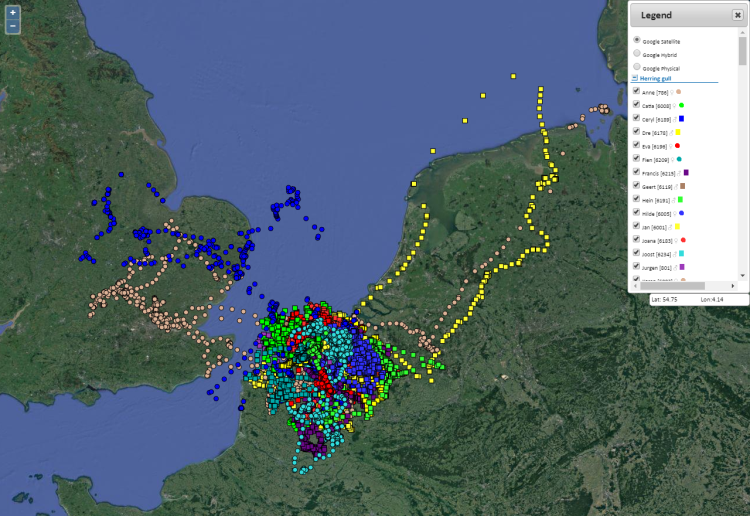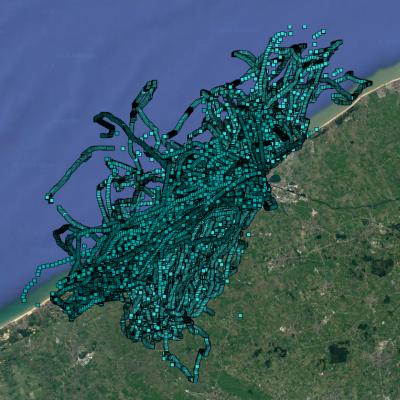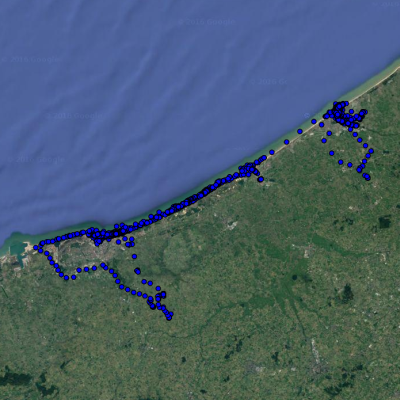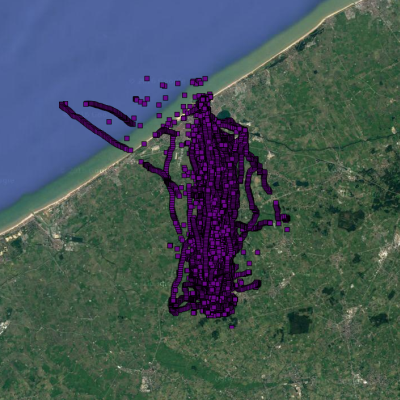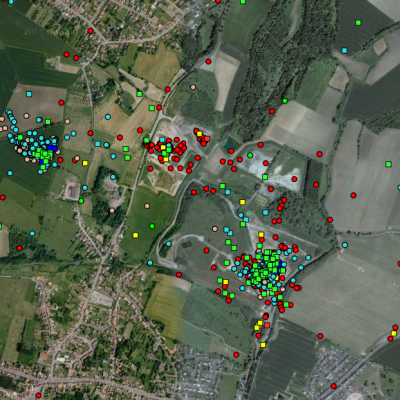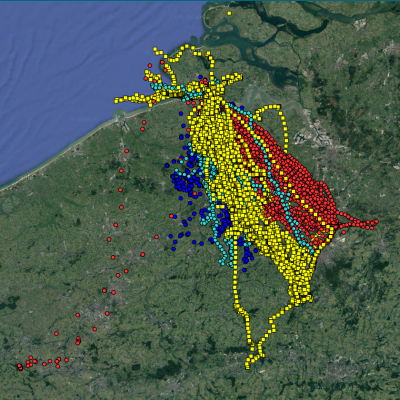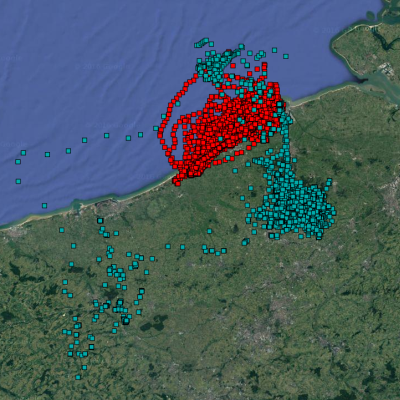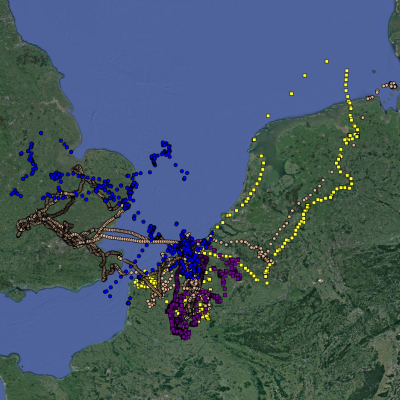You are here
Breeding season 2016
|
During the 2016 breeding season (June-July), all birds stayed relatively close to their breeding grounds: (1) the harbor of Oostende for the European Herring Gulls, (2) the harbor of Zeebrugge and (3) Vlissingen-Oost (the Netherlands) for the Lesser Black-backed Gulls, and (4) Het Krekengebied in East-Flanders for the Western Marsh Harriers. By clicking on the map on the right, you are redirected to an interactive map showing the breeding season of 2016. The map shows the data of Jurgen (a male European Herring Gull), by default, but you can select other birds in the map legend. During the breeding season, different birds display different breeding- and foraging behavior. Below you can read some peculiar stories. |
|
Joost (6234) (♂) and Tjess (6069) (♂), seemed to be two very active European Herring Gulls. While most tagged individuals of this bird species tend to stay relatively close (few km) to their breeding grounds, these two gentlemen could be found all over the place during the summer of 2016: along the Belgian coast between Oostende and Koksijde, at sea, and in the fields and meadows of the West-Flemish hinterlands. Although they covered a large foraging area, they returned to their nests every day, like a good husband/father. For an animated visualization of the very active Joost and Tjess, click on the image on the left. |
|||
|
Remember Stephanie (6036), the female European Herring Gull who left Oostende in a hurry last year? It seemed like she was very hesitant to spend the summer of 2016 in Oostende, because, before returning there, she stayed in the vicinity of Duinkerke for a while. She reappeared in Oostende by mid-June. During the remainder of summer, she only strayed a few 100 meters away from her breeding colony. When she was not on the rooftop of the VLIZ building (where the nests are), she could be found at the beach and breakwaters between Oostende and Bredene. It seemed like she was very adamant to protect her nest this year... For an animated visualization of the courageous Stephanie, click on the image on the left. |
|||
|
It seemed like Luc (799), a male European Herring Gull, had a favorite foraging spot during the summer of 2016. Almost every day he flew to a place called "De Mokker", a township of the West-Flemish town Koekelare. What was he looking for? Did the food taste better there? Was he meeting a secret lover? Or did he simply need a place to get away from the Mrs. and grumble? ("de mokker" loosely translates to "the grumbler" in English.) Whatever the reason, apart from a few small sea excursions, he always went back to De Mokker. For an animated visualization of Luc the grumbler, click on the image on the left. |
|||
|
Last year some gulls chose to avoid the crowds at the chips factory in Moeskroen, and foraged at a waste treatment facility in Blaringhem instead. However, the latter did not become a very popular spot. During the summer of 2016, several Lesser Black-backed Gulls, from both colonies (Zeebrugge and Vlissingen), could be found at a new location: a quarry or old mine in Loffre-Lewarde (in the vicinity of Dowaai, Northern France): Carrie (5304) (♀), Hilbran (849) (♂), Huub (5298) (♂), Inge (5301) (♀), Jeroen (1400) (♂), Katrien (1402) (♀), Kristof (5296) (♂), Luna (5215) (♀), Orval (5300) (♂), and Rinse (5273) (♂) were all spotted here. For an animated visualization of the quarry visitors, click on the image on the left. |
|||
|
Remember the Vlissingen Gang of the Lesser Black-backed Gulls? During the summer of 2016, many of its old and newly recruited members seemed to prefer foraging on land instead of at sea. E.g. Carsten (5200) (♂), Fay (5338) (♀), Fernand (5315) (♂), Luan (5137) (♀), Merel (5275) (♀), Mohammed (5305) (♂), Naomi (5202) (♀), Paco (5222) (♂) and Roland-Jan (5134) (♂), made regular trips to the big cities of Brussel and Gent and to some smaller cities such as Dendermonde, Lokeren and Sint-Niklaas. Sometimes they made an excursion in the Westerschelde, towards the sea, but they could never or rarely be found at the high seas. For an animated visualization of the city-loving Vlissingen Gang members, click on the image on the left. |
|||
|
It is quite clear the tagged birds are separate individuals, with their own characters and personal foraging preferences. Take Peter (4047) and Pieter (5213) for example, two male Lesser Black-backed Gulls. While Peter preferred to forage at sea and along the Belgian coast, Pieter could be found mainly on land, in the larger area around Roeselare. This completely opposite foraging behavior will also reflect in their diet: more fish and seafood for Peter, and more insects and earthworms for Pieter. For an animated visualization of Peter and Pieter, click on the image on the left. |
|||
|
Not all Lesser Black-backed Gulls who returned to the breeding colony had a nest during the summer of 2016. Harry (719) (♂), Imme (5199) (♀), Joachim (5271) (♂), Katrien (1402) (♀) and Sanne (833) (♀) most likely did not have any offspring to look after and thus were free to do whatever they wanted. Harry e.g. traveled back and forth between Zeebrugge and Moeskroen (those delicious chips!), and visited Calais and Northern France several times. By the end of June 2016, he left for a small trip around the Netherlands. It seems Harry is becoming quite the eternal bachelor, as this was (presumably) the third year in a row Harry did not have a nest. And Imme e.g. visited the small German islands of Nigehörn and Scharhörn. For an animated visualization of the litter-free birds, click on the image on the left. |
|||

